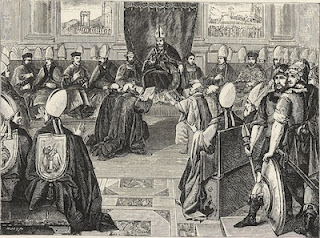In 1064 (two years before Edward the Confessor's death), Harold Godwinson (later King Harold; the most powerful lord in England after the king; his sister was married to Edward) was shipwrecked off the coast of Normandy and held captive by Count Guy of Ponthieu. (Note: This is about the only reason why anyone studying history cares about Guy of Ponthieu, but this incident was important enough to justify William's invasion that Guy makes it onto the Bayeux tapestry; that's Guy in the illustration.) Duke William of Normandy told Guy to release him; this was done, and Harold was returned to England, but only after swearing on holy relics that he would recognize William as his king in the future.
This is according to reports written long after the fact by William's chroniclers. No English source relates this arrangement, and the two Norman sources are probably relating it solely to justify what happened in 1066.
When Edward died in 1066, Harold claimed that Edward had made a deathbed pronouncement, naming Harold his heir.
There was also a third claimant to the throne, although the least convincing. King Harald Hardrada of Norway and Denmark believed that he was the proper heir, because Danes had conquered England so many times in the past. A tenuous claim, but strengthened by the fact that he was supported by Tostig, the brother of Harold Godwinson! (Ahh, the days when sibling rivalry had higher stakes!)
The problem with all these claims?
In primarily Anglo-Saxon England, the next king was chosen by the witenagemot, the meeting of wise men. Kings might name a successor, but the witanagemot was needed to approve a ruler.
So who pressed their claim?
All of them.
William's reaction and the events that followed were predictable, but I'll tell you about them anyway tomorrow.


























